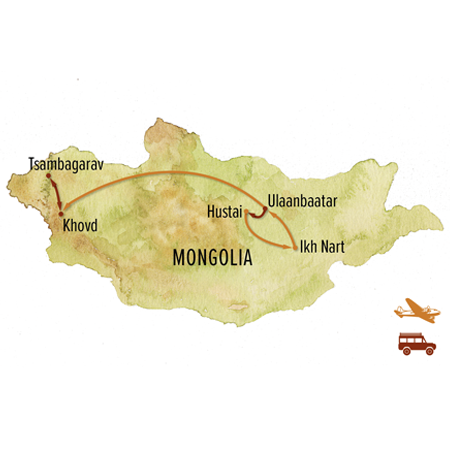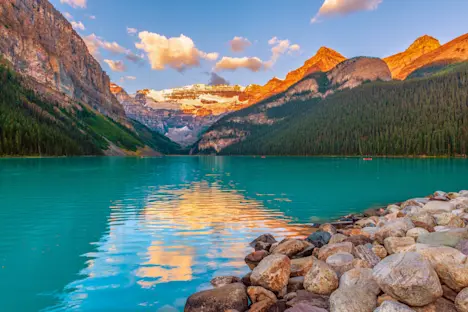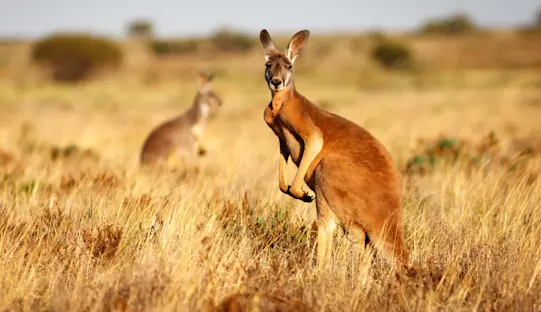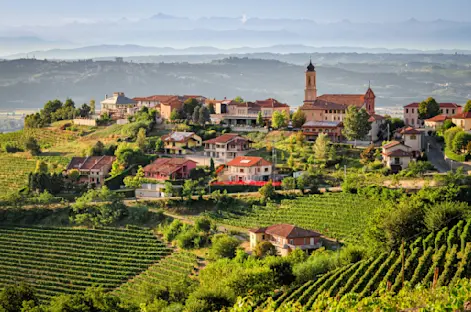Itinerary

Arrive in Mongolia’s capital of Ulaanbaatar where you’ll meet your Expedition Leader and fellow adventurers at lunch. Home to roughly half of Mongolia’s population, the city has grown rapidly in recent years as the country's rural population shifts to a more urban one. We'll walk to Sukhbaatar Square for an orientation to the city, viewing its collection of enormous statues, including Damdin Sukhbaatar, father of the 1921 Mongolian revolution, and the colonnade monument to national icon Genghis Khan in front of the Government Palace. Genghis Khan (known as Chinggis Khaan in Mongolia) remains a cultural hero, having united the Mongol tribes and conquered large parts of China and Central Asia in the 13th century.
A highlight of our city overview is a visit to the Chinggis Khaan National Museum, a stunning 9-story building opened in 2022 telling the story of Mongolia's legendary 13th-century emperor and his enduring impact on the country and the world. The state-of-the-art museum has more than 10,000 original artifacts and exhibits, enhanced with interactive technology, which span the Bronze Age to the peak of the Mongol Empire and into the present day. Later this evening, we walk together with our Expedition Leader to a local restaurant for a welcome dinner and orientation to the all the adventures ahead.

Drive west this morning to Hustai National Park, set in mountain steppe at the center of Mongolia. The park was initially established as a Specially Protected Area in 1993 to support the reintroduction of the native Takhi horse (Przewalski’s horse), which went extinct in the wild in 1969. Today, it has UNESCO status as a World Biosphere Reserve. In addition to the 450 Takhi horses that roam the park—almost half the total in Mongolia—Hustai is home to some 40 other mammal species, including wapiti, Mongolian gazelle, wild boar, ibex, gray wolf, Eurasian lynx, Pallas’s cat, red fox, Eurasian badger and Mongolian marmot. While many are elusive, we'll search for them on wildlife drives. The park has also been designated an Important Bird Area (IBA), with 271 species such as golden eagle, lammergeier, great bustard, whooper swan, black stork and little owl.
Our private mobile ger camp lies within the buffer zone, offering us special access to the park’s core zone generally reserved only for researchers. En route to camp, stop for a traditional Mongolian lunch prepared by nomad neighbors who are partners in conservation work at Hustai. Mutton is a staple, and we have a chance to try buuz (mutton dumplings) and hushuur (mutton pancakes), although arrangements can be made for guests with other dietary preferences. Our hosts will share about their traditional nomadic lifestyle, including their important relationship with their livestock and horses. Horses have been integral to life in Mongolia for centuries, and virtually all Mongolian children learn to ride as young as 3 or 4. After lunch, experience this essential part of Mongolian culture on an optional horseback ride over the steppe.
Once we reach our camp by mid-afternoon, settle into your classic felt ger—a traditional nomad yurt-style dwelling. Then load up in Land Cruisers for our first foray into the park, visiting sites of archaeological interest such as a 4,000-year-old deer stone associated with burial mounds. On our first wildlife drive, look for Takhi horses, Mongolian gazelle, wapiti and marmots. Takhi, the Mongol name for the Przewalski’s horse, is the world’s only remaining truly wild horse, more closely related to zebras than horses. It was successfully reintroduced to Mongolia in the early 1990s after individual animals were donated from zoos across the world.
Rise before dawn for an early-morning game drive into the core zone of Hustai National Park. Traveling in Land Cruisers beyond the standard tourism zone, we are accompanied by a senior park biologist who leads us in tracking Mongolian wolves. Because we are visiting in May and June, with access to the expertise of a local researcher, we have good odds to view wolves in the morning when they are near their dens, nurturing new pups. We’ll also look for other species, too, returning to camp by mid-morning for a full breakfast followed by optional activities such as a guided birding walk or a visit to prehistoric monuments nearby.
Then learn firsthand about the Mongolian Bankhar Dog Project, including the breed’s history in Mongolia, its close connection with the traditional nomadic lifestyle, and the group’s work to preserve it. We’ll meet some of the dogs that have not yet completed their training in order to be paired with a nomadic family. Later this evening, return to the park for another wildlife drive with a chance to spot nocturnal jerboas, enigmatic kangaroo-looking rodents with disproportionately large ears.
Wake very early again for another drive into the core zone of the park to look for wolves. After a light breakfast in the field, return to camp to collect our luggage and head for the private airstrip where we meet our chartered flight to Ikn Nart Nature Reserve in the Eastern Gobi. The journey by air takes only an hour. Once we land, it's a little over a half-mile walk or drive to our new ger camp. Brunch is served on arrival, then settle in to our individual gers with time to relax, take a walk, or borrow a mountain bike to explore our environs.
Later this afternoon, board Land Cruisers to scout for wildlife and get a first glimpse of Ikh Nart’s unique rock formations up close on walks into the rocky terrain and along dry riverbeds. Species to look for include enormous cinereous vultures, also known as the Eurasian black vulture, with an 8–10-foot wingspan, among the largest birds of prey in the world. Keep an eye out, too, for graceful lesser kestrels, the subject of ongoing scientific study here. We also witness important geologic and palaeontologic sites, interpreted by our Expedition Leader. Return to camp for leisure time before dinner.
Today is a full day of exploration. Again, wake very early for a nature walk when wildlife is active, and to experience sunrise over the granite rock formations. We may see argali sheep and Siberian ibex. After breakfast in the field, continue exploring with our local guide who unveils an intriguing range of archaeological sites from various eras, including rock petroglyphs, ancient burial sites and temple ruins—all layers of Mongolian cultural history are present in Ikh Nart.
After lunch, we have a chance to meet local nomad families—hardy and hospitable Gobi herders who migrate in and out of the area with their livestock. The desert steppe of the Eastern Gobi is a very different region from the mountain steppe of Hustai, and we’ll learn about how variations in climate and habitat affect nomadic ways of life. Time permitting, we’ll stop at the research center in Ikh Nart, the base for several conservation projects in the area. After dinner, join an optional night walk to look for jerboas. Two species are found at Ikh Nart, the Siberian jerboa and the northern three-toed jerboa.
Rise early for a light breakfast at camp followed by a sunrise hike to a scenic high point in the reserve, drinking in the stunning expanse surrounding us. Then we head back to the nearby airstrip to board our private chartered Cessna Caravan to Ulaanbaatar. After a mid-morning brunch at our hotel, the afternoon is at leisure to relax or explore more of the city on your own. Late this afternoon, we’re met by the local guide who joins us for the western portion of our trip, to the Altai region. We’ll have an orientation to this very different second part of our journey, with information about western Mongolian culture and the Altai mountain environment. Dinner follows at a local restaurant.
Transfer to the airport this morning for our flight to the Altai. Depending on the day of the week, we will fly into one of two cities: either Ulgii, capital of Bayan-Ulgii, Mongolia’s westernmost province, or Khovd, capital of Khovd Province. Ninety percent of the western region of Mongolia is ethnically Kazakh, and there will be ample opportunities to meet local families and experience Kazakh culture.
On landing, we drive overland to Three Eagle Camp, a rugged journey of approximately 2.5 hours. Settle into your “ger with a view,” followed by lunch at camp and exploring the surrounding area on foot with our Expedition Leader. Our camp is ideally located just 3 miles from boundary of Tsambagarav Mountain National Park. The park covers 3.7 million acres, one of the largest, most scenic and remote national parks in Mongolia. We get an introduction to it this afternoon on a short drive into Namarjin Valley to view Tsast Mountain. Tsast is the park’s highest peak at 13,757 feet. It is also an excellent location to spot vultures, eagles and other raptors that favor high-altitude environments.
This morning, we explore the Yamaat Valley, whose name means “valley with goats” in the Mongolian language. One of the largest valleys in Tsambagarav Mountain National Park, it holds the source of the Khukh Sair River and is home to Siberian ibex and gray wolves. WWF Mongolia conducted an important survey near here to measure the local snow leopard population, using camera traps throughout the stark mountain environs.
Return to camp for lunch and a traditional archery demonstration. Discover ancient Uriankhai techniques as you meet tribal archers and observe the remarkable precision and strength behind this living tradition.
This afternoon, enjoy a visit with a neighboring Kazakh family. Kazakhs live mostly in Bayan-Ulgii province, with a majority having migrated from Xinjiang (China) to Mongolia around 1910, fleeing civil war and seeking safe refuge. In 1940, a second Kazakh migration to Mongolia began with 400 families whom Mongolian leaders helped resettle in the country’s westernmost region. Today, more than 120,000 Kazakhs live in Mongolia, maintaining their traditional Central Asian nomadic lifestyle.
We are welcomed into the family’s traditional Kazakh ger, heated with a large wood-burning stove, which is distinctive in design and construction from Mongolian gers. Our hosts offer airag, traditional fermented mare’s milk tea, and hand-made curd products. Learn about their daily routines as nomadic herders, perpetuating a lifestyle that has existed largely unchanged for centuries. Kazakh women are renowned for their skills in embroidery and applique, and their gers are decorated with colorful textiles. Handcrafted felt carpets line the floor, while delicately stitched tapestries adorn the walls, each design unique to a family. Return to camp by late afternoon, followed by dinner and, weather permitting, a stargazing session with our Expedition Leader—the night skies here are some of the darkest on Earth.
After an early breakfast, drive about 90 minutes to reach the Tekht Valley in the Nuruut Mountains, an area known for its large population of Siberian ibex. As we scout for wildlife, look also for high-elevation birds like willow ptarmigan and bearded vultures. Return to camp for lunch, then set out on a scenic journey to Tavan Belchir waterfall, where the Uriankhai nomads spend the summer. En route, we stop for a dramatic view at 12,000 feet over the pasturelands of Altantugts. The falls form where the Tavan Belchir River pours off a cliff at the base of Khukh Nurgan Pass, tumbling into the valley below. At camp this evening, enjoy a traditional Kazakh dinner with a local cultural performance.
After breakfast, transfer to airport, about a 2.5-hour drive, for our flight back to Ulaanbaatar, then continue to the Taij Resort outside the city where we’ll have lunch on arrival. This afternoon, we tour the ruins of Manzushir Monastery on the south slope of Bogd Khaan Mountain. Part of Bogd Khan National Park, the setting is magnificent, surrounded by pine-scented hillsides, rocky outcrops, flowing streams and lush valleys where wildlife roams. Bogd Khan Mountain has been a protected reserve since the 13th century, while the Buddhist monastery was built in 1773. At one time, more than 1,000 monks lived among the 70 temples on the site. It was destroyed in 1932 during the Communist purges, but the main temple has since been rebuilt. One item from the original monastery that survived is a two-ton bronze cauldron designed to cook food for a thousand monks in a single sitting—it could boil the meat of 10 sheep or two cows at a time. A visit to the small museum on the site offers an overview of the region's natural history, plus religious dance masks, Buddhist thanka paintings, musical instruments, and an artist’s rendition of what the monastery looked like prior to its destruction. On a walk through the valley, we reach the reconstructed temple for a look inside. Return to resort for a farewell dinner.
Our grand Mongolian adventure comes to an end this morning. Depending on the time of your departing flight, breakfast will be either packed to go, or at the hotel restaurant. A transfer to the airport in Ulanbaataar is included, timed for your international flight.

































